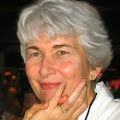This post first published here on December 14, 2008.
~~~~~~~~~
1. When Rachel stared at her, Lina blinked and cocked her head, then groaned.
“Then, like a dog hearing a sound on some inaudible frequency, he cocked his head. Kenan Vartan emerged onto the patio in full uniform and saluted smartly. The Premier, his ebony eyes fastened intensely on Vartan, gave a curt nod, as did Desmond, who thought how ridiculous the salute would look were Vartan too wearing shorts and sandals.” (Katherine V. Forrest, Daughters of an Amber Dawn, 2002)
The cocked head, smart salute, and curt nod don’t offend me here, because they’re appropriate and not overused. So whether you're writing or editing, check for empty fillers and replace them with meaningful actions and gestures.
~~~~~~~~~
A novel crammed with empty fillers turns me off, especially when I’m editing it and am forced to watch characters endlessly smile, grin, and nod.
Here are five sentences filled with examples of what I mean. See how many you can spot:
Here are five sentences filled with examples of what I mean. See how many you can spot:
1. When Rachel stared at her, Lina blinked and cocked her head, then groaned.
2. Lara smirked at Betty, then shook her head and grinned.
3. Sarah swallowed hard and stretched her lips into a huge smile.
4. Sandy squared her shoulders, narrowed her eyes, and raised her eyebrows.
5. As Maureen approached, Connie nodded her head, blushed, and smiled.
The author usually has a good motive. She seems to know that she needs to break the dialogue with some type of action or gesture, but she chooses a tired word or phrase and inserts it without much thought.
I’m always thrilled to read passages such as the following:
The author usually has a good motive. She seems to know that she needs to break the dialogue with some type of action or gesture, but she chooses a tired word or phrase and inserts it without much thought.
I’m always thrilled to read passages such as the following:
“Then, like a dog hearing a sound on some inaudible frequency, he cocked his head. Kenan Vartan emerged onto the patio in full uniform and saluted smartly. The Premier, his ebony eyes fastened intensely on Vartan, gave a curt nod, as did Desmond, who thought how ridiculous the salute would look were Vartan too wearing shorts and sandals.” (Katherine V. Forrest, Daughters of an Amber Dawn, 2002)
The cocked head, smart salute, and curt nod don’t offend me here, because they’re appropriate and not overused. So whether you're writing or editing, check for empty fillers and replace them with meaningful actions and gestures.
 |
| Shelley Thrasher has a PhD in English and specializes in editing novels written by women. She spends most of her time style-editing for Bold Strokes Books. She also enjoys writing poetry and novels, which you can find on Amazon. |


This definitely a good reminder. On the 'good' piece you quoted, however, how do you feel about the 'ebony eyes'? I would tend to leave that out as filler too - not to mention most folks don't actually have ebony eyes.
ReplyDeleteThanks for your comment. In response to your question about "ebony eyes," I wouldn't consider that phrase empty filler, primarily because it's more interesting than "jet black eyes," which I encounter too often.
ReplyDelete"Ebony" makes me see a color (brownish black to black); texture (hard and slick, if I think of piano keys or rough, if I think about its origin as tree bark); and a quality (durable). If a word can evoke a lot of associations like that, I keep it.
I'm so confused by which is better. I can't distinguish between the styles.
ReplyDeleteIf you're confused about the "ebony eyes" discussion, my bottom line is that since the phrase if not a cliche, I would keep it. If she had written "jet black eyes" I might have been tempted to delete it.
ReplyDeleteConfusion is good. It shows that you're thinking. And these are judgment calls that each editor has to make for herself. Style editing deals with as many if not more gray areas than black-and-white.
Good post and could not agree more. The filler stuff is killing stuff to an oftentimes otherwise good manuscript.
ReplyDeleteThanks for the advice, very helpful. I tend to have far too much smiling too.
ReplyDeleteAlways a tough line to walk, between "business" bits to help identify the speaker in long duologues and the sort of useless business you've quoted here. I try to introduce "business" bits that connect characters: physical touch, sharing of objects, physical actions embedded in dialogue that help obviate the need for adverbs. I'm sure I fall into the trap, but I try. Thanks for helping to keep us more aware of it!
ReplyDeleteI endlessly smile, grin and nod, too ... I'm told that makes me a candidate for the laughing academy ... my response is to smile, grin and nod.
ReplyDelete"Sandy squared her shoulders, narrowed her eyes, and raised her eyebrows."
ReplyDeleteI tried. I cannot narrow my eyes AND raise my eyebrows :)
Thanks for a good reminder!
Love it! I was just sitting here wondering how I'm going to make my characters smile with a little more creativity. :)
ReplyDeleteWhat sane, cogent advice. If anyone reading this is ever in a position to hear author Tim Esaias's talk on Bobbleheadisms, it expounds on this in wonderful ways.
ReplyDeleteSomeone once told me that scene creation should not read like theatre direction. I agree. Creating a clear mental picture in the mind of the reader without resorting to the simple smile-grin-nod syndrome is an art.
ReplyDeleteFantastic thoughts. Thanks so much for sharing. I will definitely spend a full draft going through my novel for every tired action I added just to break up the dialogue!
ReplyDelete